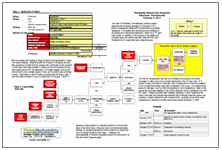When Line 132 ruptured last September in the community of San Bruno, California, emergency personnel were quick to respond to the natural gas explosion. The first fire truck was on scene within six minutes of the explosion. What responders found was a chaotic scene, with multiple wounded and killed and swaths of the neighborhood in flames or simply flattened. Little did they know that a large natural gas transmission line, feeding the spreading fire, was directly beneath them. Emergency personnel did their best to clear homes and evacuate the wounded as the fire spread, but the confusion continued for nearly 90 minutes until the gas valves were shut off upstream from the fire.
The subsequent National Transportation Safety Board (NTSB) investigations focused on Pacific Gas and Electric (PG&E) processes following the accident, and found that PG&E was woefully unable to respond quickly to a crisis of this magnitude. As a set of timelines show, emergency response personnel were already on scene long before PG&E was even aware that a pipeline rupture may be associated with a local fire. PG&E apparently did not notice an alarm warning them of a pressure drop. Control systems detected a severe pressure drop approximately four minutes after the disruption; however the PG&E gas control center, located in San Francisco, remained unaware of the explosion and fire until a PG&E dispatch center in Concord called them. Off duty employees had called-in to the Concord dispatch center 7 and 11 minutes after the incident, alerting them of a large fire in San Bruno. However it was not until the dispatch center called the gas control center 16 minutes after the explosion that gas control operators realized what was happening. By this point emergency responders had already arrived at the scene, unaware of the large natural gas pipeline directly under the neighborhood.
What information did emergency responders have as they arrived on scene that day? Although PG&E itself was aware of the likely service disruption, they failed to notify first responders of any potential danger in those critical minutes after the explosion. Additionally according to NTSB testimony, the fire department was unaware of the large natural gas pipeline under the community. Larger transmission pipelines have different operating characteristics than smaller distribution pipelines, including different recommended safety precautions and shut down times. With a better awareness of the pipeline locations and associated dangers, emergency response personnel could have developed training and response procedures ahead of time for an explosion of this magnitude. PG&E has since taken steps to enhance its partnership with first responders and other public safety organizations. Clearly there are other steps that need to be taken as well.
 When conducting an investigation, a timeline can be a helpful tool to organize information. While straightforward to build, timelines can identify areas needing more research and aid in building a process map and a Cause Map. Compare what happened at PG&E to what emergency responders were doing. You’ll notice there was a significant delay at PG&E in recognizing there was a problem and then acting upon it. It took nearly 90 minutes to close valves to shut transmission lines. Changes must be made to speed up PG&E’s procedures in a crisis situation.
When conducting an investigation, a timeline can be a helpful tool to organize information. While straightforward to build, timelines can identify areas needing more research and aid in building a process map and a Cause Map. Compare what happened at PG&E to what emergency responders were doing. You’ll notice there was a significant delay at PG&E in recognizing there was a problem and then acting upon it. It took nearly 90 minutes to close valves to shut transmission lines. Changes must be made to speed up PG&E’s procedures in a crisis situation.
Likewise process maps are a useful tool for determining where a process can use improvement. In the Current process map, it is noticeable that there are three parallel processes occurring, where information is not being shared in an efficient manner. The PG&E Dispatch Center only shares information with the Emergency Dispatch Center after they have fully assessed the situation. This information might come after the fact, as it did in San Bruno, or seriously delay an effective response by EMTs and firefighters. Going one step further, trained emergency personnel might be able to check with local utilities if they have reason to suspect a natural gas pipeline is involved. Simple procedural changes, such as who is notified and when, can have significant impacts.
It is important to note that the timeline helps create the most accurate “As Occurred” process map (called Current in this case). Procedures can differ from actual processes, so it is important to document what actually happened, identify differences in what should have occurred, and figure out why it didn’t. In this case, PG&E’s procedures were followed and need to be revised.
The NTSB recommendations will undoubtedly lead to multiple changes. It is easy to focus on material solutions, which tend to be expensive to implement. Some changes under consideration are the use of remote controlled valves and the replacement of aging pipes. While there is no doubt that these changes need to happen, other changes can help in the meantime. Process maps can help identify procedural changes which may be much less expensive, such a modifying notification procedures.
A detailed Cause Map built after the preliminary investigation shows what NTSB investigators believe led the natural gas leak. More information on the NTSB investigation can be found here.









 Specifically, the committee was concerned that the study focused on decisions made on the rig (generally by personnel who worked for other companies) but did not adequately consider input from these companies.
Specifically, the committee was concerned that the study focused on decisions made on the rig (generally by personnel who worked for other companies) but did not adequately consider input from these companies.